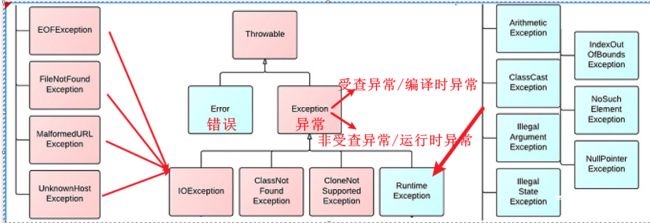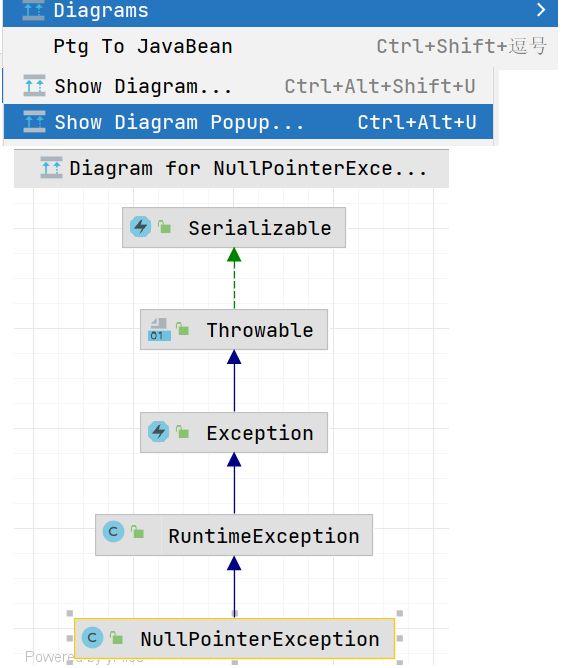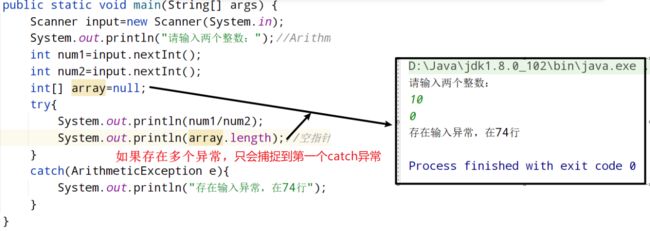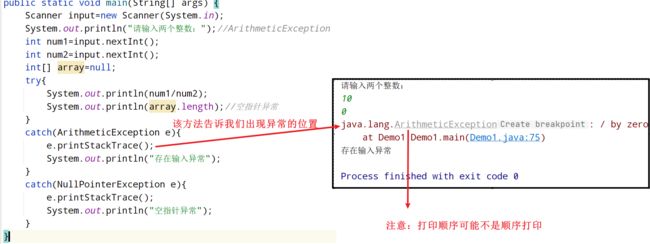教你精通JavaSE语法之第十一章、认识异常
一、异常的概念与体系结构
1.1异常的概念
在Java中,将程序执行过程中发生的不正常行为称为异常。比如之前写代码时经常遇到的:
1.算术异常
System.out.println(10 / 0);
// 执行结果
Exception in thread "main" java.lang.ArithmeticException: / by zero2.数组越界异常
int[] arr = {1, 2, 3};
System.out.println(arr[100]);
// 执行结果
Exception in thread "main" java.lang.ArrayIndexOutOfBoundsException: 1003.空指针异常
int[] arr = null;
System.out.println(arr.length);
// 执行结果
Exception in thread "main" java.lang.NullPointerException从上述过程中可以看到,java中不同类型的异常,都有与其对应的类来进行描述。
1.2异常的体系结构
异常种类繁多,为了对不同异常或者错误进行很好的分类管理,Java内部维护了一个异常的体系结构:
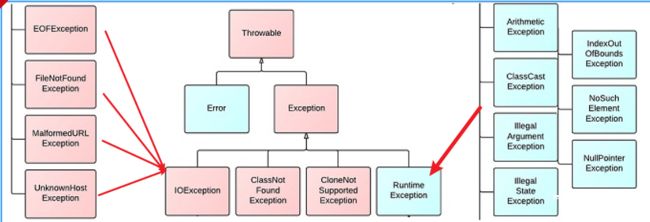
从上图中可以看到:
1. Throwable:是异常体系的顶层类,其派生出两个重要的子类, Error 和 Exception
2. Error:指的是Java虚拟机无法解决的严重问题,比如:JVM的内部错误、资源耗尽等,典型代表:StackOverflowError和OutOfMemoryError,一旦发生回力乏术。
3. Exception:异常产生后程序员可以通过代码进行处理,使程序继续执行。比如:感冒、发烧。我们平时所说的异常就是Exception。
1.3异常的分类
1.3.1编译时异常
在程序编译期间发生的异常,称为编译时异常,也称为受检查异常(Checked Exception)
public class Person {
private String name;
private String gender;
int age;
// 想要让该类支持深拷贝,覆写Object类的clone方法即可
@Override
public Person clone() {
return (Person)super.clone();
}
//编译时报错:
//Error:(17, 35) java: 未报告的异常错误java.lang.CloneNotSupportedException; 必须对其进行捕获或声明以便抛出
}1.3.2运行时异常
在程序执行期间发生的异常,称为运行时异常,也称为非受检查异常(Unchecked Exception)
RunTimeException以及其子类对应的异常,都称为运行时异常。比如:NullPointerException、
ArrayIndexOutOfBoundsException、ArithmeticException。
注意:编译时出现的语法性错误,不能称之为异常。例如将 System.out.println 拼写错了, 写成了
system.out.println. 此时编译过程中就会出错, 这是 "编译期" 出错。而运行时指的是程序已经编译通过得到class 文件了, 再由 JVM 执行过程中出现的错误
小知识:
1.程序异常的情况:
程序正常返回0:
2.继承图:
二、异常的处理
2.1防御式编程
错误在代码中是客观存在的. 因此我们要让程序出现问题的时候及时通知程序猿. 主要的方式:
2.1.1事前防御型
LBYL: Look Before You Leap. 在操作之前就做充分的检查.
boolean ret = false;
ret = 登陆游戏();
if (!ret) {
处理登陆游戏错误;
return;
} ret = 开始匹配();
if (!ret) {
处理匹配错误;
return;
} ret = 游戏确认();
if (!ret) {
处理游戏确认错误;
return;
} ret = 选择英雄();
if (!ret) {
处理选择英雄错误;
return;
} ret = 载入游戏画面();
if (!ret) {
处理载入游戏错误;
return;
}
......缺陷:正常流程和错误处理流程代码混在一起, 代码整体显的比较混乱
2.1.2事后认错型
It's Easier to Ask Forgiveness than Permission. "事后获取原谅比事前获取许可更容易". 也就是先操作, 遇到问题再处理.
try {
登陆游戏();
开始匹配();
游戏确认();
选择英雄();
载入游戏画面();
...
} catch (登陆游戏异常) {
处理登陆游戏异常;
} catch (开始匹配异常) {
处理开始匹配异常;
} catch (游戏确认异常) {
处理游戏确认异常;
} catch (选择英雄异常) {
处理选择英雄异常;
} catch (载入游戏画面异常) {
处理载入游戏画面异常;
}
......优势:正常流程和错误流程是分离开的, 程序员更关注正常流程,代码更清晰,容易理解代码
异常处理的核心思想就是 EAFP。
在Java中,异常处理主要的5个关键字:throw、try、catch、final、throws。
2.2异常的抛出
在编写程序时,如果程序中出现错误,此时就需要将错误的信息告知给调用者,比如:参数检测。在Java中,可以借助throw关键字,抛出一个指定的异常对象,将错误信息告知给调用者。具体语法如下:
throw new XXXException("异常产生的原因");【需求】:实现一个获取数组中任意位置元素的方法
public static int getElement(int[] array, int index){
if(null == array){
throw new NullPointerException("传递的数组为null");
} if(
index < 0 || index >= array.length){
throw new ArrayIndexOutOfBoundsException("传递的数组下标越界");
} return array[index];
}
public static void main(String[] args) {
int[] array = {1,2,3};
getElement(array, 3);
}【注意事项】
1. throw必须写在方法体内部
2. 抛出的对象必须是Exception 或者 Exception 的子类对象
3. 如果抛出的是 RunTimeException 或者 RunTimeException 的子类,则可以不用处理,直接交给JVM来处理
4. 如果抛出的是编译时异常/受查异常,用户必须自己处理,否则无法通过编译
5. 异常一旦抛出,其后的代码就不会执行
2.3异常的捕获
异常的捕获,也就是异常的具体处理方式,主要有两种:异常声明throws 以及 try-catch捕获处理
2.3.1异常声明throws
处在方法声明时参数列表之后,当方法中抛出编译时异常,用户不想处理该异常,此时就可以借助throws将异常抛给方法的调用者来处理。即当前方法不处理异常,提醒方法的调用者处理异常。
语法格式:
修饰符 返回值类型 方法名(参数列表) throws 异常类型1,异常类型2...{
}//克隆方法
class People implements Cloneable{
protected Object clone() throws CloneNotSupportedException{
return super.clone();
}
}
public class Demo2 {
public static void main(String[] args) throws CloneNotSupportedException{
People people1=new People();
People people2=(People)people1.clone();
}
}【注意事项】
1. throws必须跟在方法的参数列表之后
2. 声明的异常必须是 Exception 或者 Exception 的子类
3. 方法内部如果抛出了多个异常,throws之后必须跟多个异常类型,之间用逗号隔开,如果抛出多个异常类型具有父子关系,直接声明父类即可。4.调用声明抛出异常的方法时,调用者必须对该异常进行处理,或者继续使用throws抛出
public static void main(String[] args) throws IOException {
Config config = new Config();
config.openConfig("config.ini");
}将光标放在抛出异常方法上,alt + Insert 快速 处理:
2.3.2try-catch捕获并处理
throws对异常并没有真正处理,而是将异常报告给抛出异常方法的调用者,由调用者处理。如果真正要对异常进行处理,就需要try-catch。
语法格式:
try{
// 将可能出现异常的代码放在这里
}catch(要捕获的异常类型 e){
// 如果try中的代码抛出异常了,此处catch捕获时异常类型与try中抛出的异常类型一致时,或者是try中抛出异常的基类时,就会被捕获到
// 对异常就可以正常处理,处理完成后,跳出try-catch结构,继续执行后序代码
}[catch(异常类型 e){
// 对异常进行处理
}finally{
// 此处代码一定会被执行到
}]
// 后序代码
// 当异常被捕获到时,异常就被处理了,这里的后序代码一定会执行
// 如果捕获了,由于捕获时类型不对,那就没有捕获到,这里的代码就不会被执行 注意:
1. []中表示可选项,可以添加,也可以不用添加
2. try中的代码可能会抛出异常,也可能不会3.如果是非受查异常,我们并没有对该异常进行处理,那么这个异常会交给JVM处理,此时程序会异常终止。此时通过try-catch可以解决后面的代码也被执行。
4.try中的语句如果抛出异常,那么接下来的在try的异常语句后面的语句不会被执行。
例子一:
//try-catch
public static void main(String[] args) {
Scanner input=new Scanner(System.in);
System.out.println("请输入两个整数:");//ArithmeticException
int num1=input.nextInt();
int num2=input.nextInt();
try{
System.out.println(num1/num2);
}
catch(ArithmeticException e){
System.out.println("存在输入异常,在74行");
}
}例子二:
public static void main(String[] args) {
Scanner input=new Scanner(System.in);
System.out.println("请输入两个整数:");//ArithmeticException
int num1=input.nextInt();
int num2=input.nextInt();
try{
System.out.println(num1/num2);
System.out.println(num1+num2);
}
catch(ArithmeticException e){
System.out.println("存在输入异常,在74行");
}
}例子三:假如存在多个异常?都会被捕获吗?
public static void main(String[] args) {
Scanner input=new Scanner(System.in);
System.out.println("请输入两个整数:");//ArithmeticException
int num1=input.nextInt();
int num2=input.nextInt();
int[] array=null;
try{
System.out.println(num1/num2);
System.out.println(array.length);//空指针异常
}
catch(ArithmeticException e){
System.out.println("存在输入异常,在74行");
}
}也就是说:不可能同时捕获多个异常!
例子四:优化异常代码-->更高的可读性
public static void main(String[] args) {
Scanner input=new Scanner(System.in);
System.out.println("请输入两个整数:");//ArithmeticException
int num1=input.nextInt();
int num2=input.nextInt();
int[] array=null;
try{
System.out.println(num1/num2);
System.out.println(array.length);//空指针异常
}
catch(ArithmeticException e){
e.printStackTrace();
System.out.println("存在输入异常");
}
catch(NullPointerException e){
e.printStackTrace();
System.out.println("空指针异常");
}
}关于异常的处理方式:异常的种类有很多, 我们要根据不同的业务场景来决定.
- 对于比较严重的问题(例如和算钱相关的场景), 应该让程序直接崩溃, 防止造成更严重的后果
- 对于不太严重的问题(大多数场景), 可以记录错误日志, 并通过监控报警程序及时通知程序猿
- 对于可能会恢复的问题(和网络相关的场景), 可以尝试进行重试.
- 在我们当前的代码中采取的是经过简化的第二种方式. 我们记录的错误日志是出现异常的方法调用信息, 能很快速的让我们找到出现异常的位置. 以后在实际工作中我们会采取更完备的方式来记录异常信息.
【注意事项】
1. try块内抛出异常位置之后的代码将不会被执行
2. 如果抛出异常类型与catch时异常类型不匹配,即异常不会被成功捕获,也就不会被处理,继续往外抛,直到JVM收到后中断程序----异常是按照类型来捕获的public static void main(String[] args) { int[] array = {1,2,3}; getElement(array, 3); } public static void main(String[] args) { try { int[] array = {1,2,3}; System.out.println(array[3]); // 此处会抛出数组越界异常 }catch (NullPointerException e){ // 捕获时候捕获的是空指针异常--真正的异常无法被捕获到 e.printStackTrace(); } System.out.println("后序代码"); } Exception in thread "main" java.lang.ArrayIndexOutOfBoundsException: 3 at day20210917.ArrayOperator.main(ArrayOperator.java:24)3. try中可能会抛出多个不同的异常对象,则必须用多个catch来捕获----即多种异常,多次捕获。
public static void main(String[] args) { int[] arr = {1, 2, 3}; try { System.out.println("before"); // arr = null; System.out.println(arr[100]); System.out.println("after"); } catch (ArrayIndexOutOfBoundsException e) { System.out.println("这是个数组下标越界异常"); e.printStackTrace(); } catch (NullPointerException e) { System.out.println("这是个空指针异常"); e.printStackTrace(); } System.out.println("after try catch"); }4.如果多个异常的处理方式是完全相同, 也可以写成这样:(不建议这样写,可读性差)
catch (ArrayIndexOutOfBoundsException | NullPointerException e) { ... }5.如果异常之间具有父子关系,一定是子类异常在前catch,父类异常在后catch,否则语法错误:
public static void main(String[] args) { Scanner input=new Scanner(System.in); System.out.println("请输入两个整数:");//ArithmeticException int num1=input.nextInt(); int num2=input.nextInt(); int[] array=null; try{ System.out.println(num1/num2); System.out.println(array.length);//空指针异常 } catch(Exception e){ } catch(ArithmeticException e){ System.out.println("存在输入异常"); e.printStackTrace(); } catch(NullPointerException e){ e.printStackTrace(); System.out.println("空指针异常"); } }修改如下:
public static void main(String[] args) { Scanner input=new Scanner(System.in); System.out.println("请输入两个整数:");//ArithmeticException int num1=input.nextInt(); int num2=input.nextInt(); int[] array=null; try{ System.out.println(num1/num2); System.out.println(array.length);//空指针异常 } catch(ArithmeticException e){ System.out.println("存在输入异常"); e.printStackTrace(); } catch(NullPointerException e){ e.printStackTrace(); System.out.println("空指针异常"); } catch(Exception e){ } }建议从上往下先捕捉子类异常后捕捉父类异常。
2.3.3 finally
在写程序时,有些特定的代码,不论程序是否发生异常,都需要执行,比如程序中打开的资源:网络连接、数据库连接、IO流等,在程序正常或者异常退出时,必须要对资源进进行回收。另外,因为异常会引发程序的跳转,可能导致有些语句执行不到,finally就是用来解决这个问题的
语法格式:
try{
// 可能会发生异常的代码
}catch(异常类型 e){
// 对捕获到的异常进行处理
}finally{
// 此处的语句无论是否发生异常,都会被执行到
}
// 如果没有抛出异常,或者异常被捕获处理了,这里的代码也会执行public static void main(String[] args) {
try{
int[] arr = {1,2,3};
arr[100] = 10;
arr[0] = 10;
}catch (ArrayIndexOutOfBoundsException e){
System.out.println(e);
}finally {
System.out.println("finally中的代码一定会执行");
} System.out.println("如果没有抛出异常,或者异常被处理了,try-catch后的代码也会执行");
}问题:既然 finally 和 try-catch-finally 后的代码都会执行,那为什么还要有finally呢?
需求:实现getData方法,内部输入一个整形数字,然后将该数字返回,并再main方法中打印
public class TestFinally {
public static int getData() {
Scanner sc = null;
try {
sc = new Scanner(System.in);
int data = sc.nextInt();
return data;
} catch (InputMismatchException e) {
e.printStackTrace();
} finally {
System.out.println("finally中代码");
}
System.out.println("try-catch-finally之后代码");
if (null != sc) {
sc.close();
}
return 0;
}
public static void main(String[] args) {
int data = getData();
System.out.println(data);
}
}
//正常输入时程序运行结果:
100
finally中代码
100
上述程序,如果正常输入,成功接收输入后程序就返回了,try-catch-finally之后的代码根本就没有执行,即输入流就没有被释放,造成资源泄漏。
注意:finally中的代码一定会执行的,一般在finally中进行一些资源清理的扫尾工作
public static void main(String[] args) {
Scanner input=new Scanner(System.in);
System.out.println("请输入两个整数:");//ArithmeticException
int num1=input.nextInt();
int num2=input.nextInt();
int[] array=null;
try{
System.out.println(num1/num2);
System.out.println(array.length);//空指针异常
}
catch(ArithmeticException e){
System.out.println("存在输入异常");
e.printStackTrace();
}
catch(NullPointerException e){
e.printStackTrace();
System.out.println("空指针异常");
}
catch(Exception e){
}
finally{
input.close();
//Scanner用完需要关闭!
}
}finally 执行的时机是在方法返回之前(try 或者 catch 中如果有 return 会在这个 return 之前执行 finally). 但是如果finally 中也存在 return 语句, 那么就会执行 finally 中的 return, 从而不会执行到 try 中原有的 return。
一般我们不建议在 finally 中写 return (被编译器当做一个警告)
【面试题】:
1. throw 和 throws 的区别?
throw是抛出一个异常,throws表示该方法声明有可能抛出异常
2. finally中的语句一定会执行吗?
必然执行
2.4异常的处理流程
关于 "调用栈"
方法之间是存在相互调用关系的, 这种调用关系我们可以用 "调用栈" 来描述. 在 JVM 中有一块内存空间称为"虚拟机栈" 专门存储方法之间的调用关系. 当代码中出现异常的时候, 我们就可以使用 e.printStackTrace(); 的方式查看出现异常代码的调用栈.
如果本方法中没有合适的处理异常的方式, 就会沿着调用栈向上传递
public static void func(int a){
System.out.println(10/a);
}
public static void main(String[] args) {
func(0);
}
//先调用main方法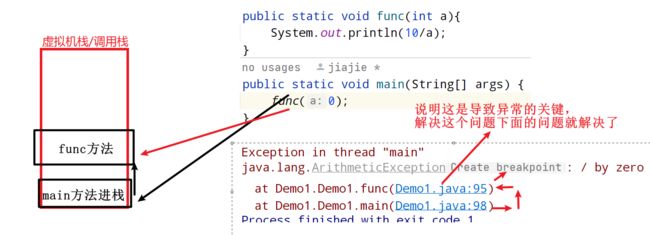 如果向上一直传递都没有合适的方法处理异常, 最终就会交给 JVM 处理, 程序就会异常终止(和我们最开始未使用 try catch 时是一样的)
如果向上一直传递都没有合适的方法处理异常, 最终就会交给 JVM 处理, 程序就会异常终止(和我们最开始未使用 try catch 时是一样的)
public static void main(String[] args) {
func();
System.out.println("after try catch");
}
public static void func() {
int[] arr = {1, 2, 3};
System.out.println(arr[100]);
} // 执行结果
Exception in thread "main" java.lang.ArrayIndexOutOfBoundsException: 100
at demo02.Test.func(Test.java:14)
at demo02.Test.main(Test.java:8)可以看到, 程序已经异常终止了, 没有执行到 System.out.println("after try catch"); 这一行。
【异常处理流程总结】
- 程序先执行 try 中的代码
- 如果 try 中的代码出现异常, 就会结束 try 中的代码, 看和 catch 中的异常类型是否匹配.
- 如果找到匹配的异常类型, 就会执行 catch 中的代码
- 如果没有找到匹配的异常类型, 就会将异常向上传递到上层调用者.
- 无论是否找到匹配的异常类型, finally 中的代码都会被执行到(在该方法结束之前执行).
- 如果上层调用者也没有处理的了异常, 就继续向上传递
- 一直到 main 方法也没有合适的代码处理异常, 就会交给 JVM 来进行处理, 此时程序就会异常终止
三、自定义异常类
Java 中虽然已经内置了丰富的异常类, 但是并不能完全表示实际开发中所遇到的一些异常,此时就需要维护符合我们实际情况的异常结构.
例如, 我们实现一个用户登陆功能.
public class LogIn {
private String userName = "admin";
private String password = "123456";
public static void loginInfo(String userName, String password) {
if (!this.userName.equals(userName)) {
System.out.println("用户名错误");
}
if(!this.password.equals(password)) {
System.out.println("密码错误");
}
System.out.println("登陆成功");
}
public static void main(String[] args) {
LogIn lg=new LogIn();
lg.loginInfo("admin", "123456");
}
}此时我们在处理用户名密码错误的时候可能就需要抛出两种异常. 我们可以基于已有的异常类进行扩展(继承), 创建和我们业务相关的异常类
具体方式:
1. 自定义异常类,然后继承自Exception 或者 RunTimeException
2. 实现一个带有String类型参数的构造方法,参数含义:出现异常的原因
如果我们继承受查异常:需要我们自己进行处理-->try-catch
class UserNameException extends Exception {
public UserNameException(String message) {
super(message);
}
}
class PasswordException extends Exception {
public PasswordException(String message) {
super(message);
}
}public class LogIn {
private String userName = "admin";
private String password = "123456";
public static void loginInfo(String userName, String password)
throws UserNameException,PasswordException{
if (!userName.equals(userName)) {
throw new UserNameException("用户名错误!");
} if
(!password.equals(password)) {
throw new PasswordException("用户名错误!");
} System.out.println("登陆成功");
}
public static void main(String[] args) {
try {
loginInfo("admin", "123456");
} catch (UserNameException e) {
e.printStackTrace();
} catch (PasswordException e) {
e.printStackTrace();
}
}
}如果我们继承非受查异常:此时不需要自己处理
class UserNameException extends Exception {
public UserNameException(String message) {
super(message);
}
}
class PasswordException extends RuntimeExceptionException {
public PasswordException(String message) {
super(message);
}
}public class LogIn {
private String userName = "admin";
private String password = "123456";
public static void loginInfo(String userName, String password)
throws UserNameException,PasswordException{
if (!userName.equals(userName)) {
throw new UserNameException("用户名错误!");
} if
(!password.equals(password)) {
throw new PasswordException("用户名错误!");
} System.out.println("登陆成功");
}
public static void main(String[] args) {
loginInfo("admin", "123456");
}
}
注意事项
- 自定义异常通常会继承自 Exception 或者 RuntimeException
- 继承自 Exception 的异常默认是受查异常
- 继承自 RuntimeException 的异常默认是非受查异常
